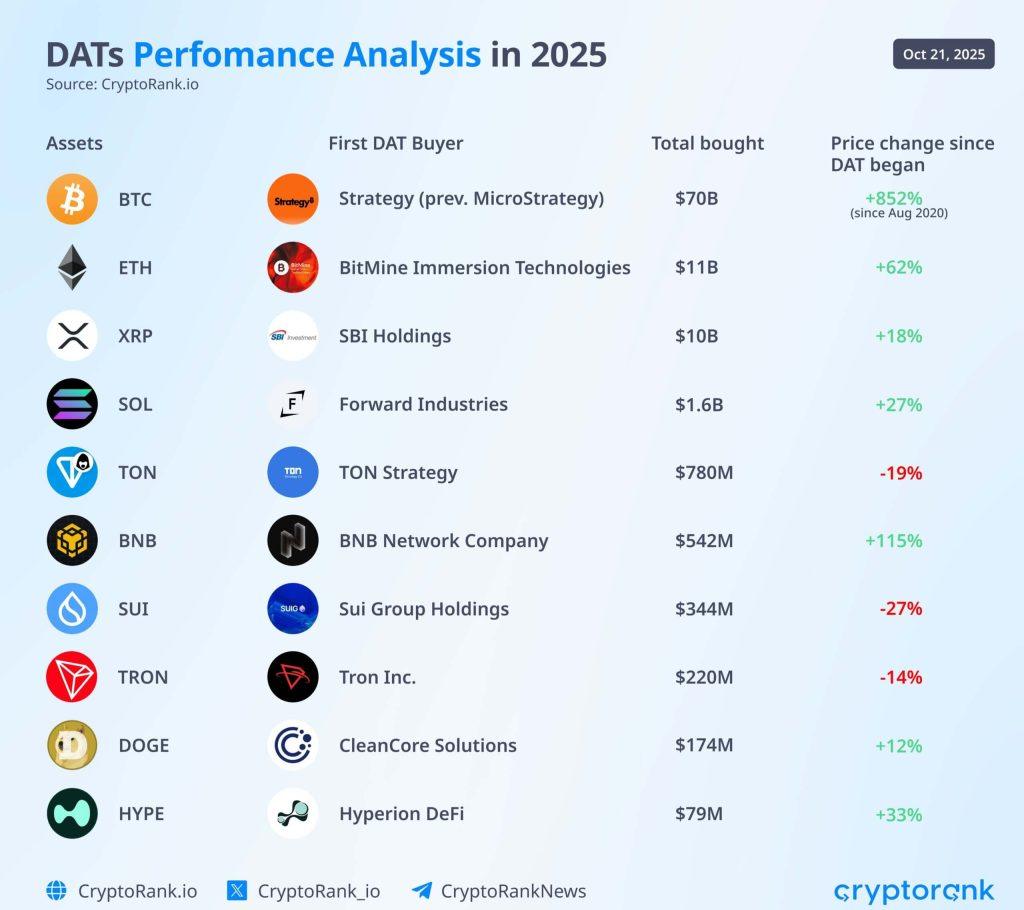Investors long paid premiums for Digital Asset Treasury firms, seeing them as practical substitutes for holding Bitcoin when direct access was limited.
That approach worked when regulated channels were scarce and corporate balance sheets offered the closest approximation to holding the asset itself.
But according to Matt Hougan, chief investment officer at Bitwise Asset Management, the conditions that once supported those valuations have fundamentally changed.
In a valuation framework released on Nov. 23, Hougan argued that the $130 billion sector now faces a structural shift.
While the forces pushing DATs below the value of their crypto holdings, illiquidity, operating costs, and execution risk, are constant across the model, the factors that can lift valuations above parity are limited and uncertain. The natural state of a passive treasury, he wrote, is a discount.
Shift toward discount valuations
Hougan’s analysis challenges the assumptions that fueled the rise of companies such as Strategy (formerly MicroStrategy) and Metaplanet Inc., which built investment cases around holding large quantities of Bitcoin.
His model treats spot-value parity as the starting point and subtracts three predictable valuation drags.
The first is illiquidity. Bitcoin held inside a corporation cannot be redeemed directly by shareholders, and the friction between ownership and access typically results in a discount. Hougan described this gap as the price investors assign to delayed or constrained delivery of the underlying asset.
The second is operating expense. Public companies incur recurring costs, including compensation, audits, custody arrangements, and legal services. Those expenses reduce net asset value on a continuous basis, meaning a dollar of Bitcoin held by a corporation is inherently worth less than a dollar held directly.
The third is execution risk. Investors must account for the possibility that management will misallocate capital, misjudge markets, or face regulatory setbacks. Because the probability is non-zero, markets generally factor this risk into pricing.
Hougan wrote:
“Most of the reasons they should trade at a discount are certain and most of the reasons they might trade at a premium are uncertain…Expenses and risk compound over time.”
Taken together, these factors form the baseline markdown that applies to most DAT structures before any upside levers are considered.
ETF competition resets landscape
The downward pressure on DAT valuations has intensified with the expansion of spot Bitcoin and Ether exchange-traded funds.
Before ETF approvals, corporate treasuries served as the primary entry point for institutions and retail investors seeking regulated exposure without the custody complexity. That scarcity allowed some DAT stocks to trade well above their underlying holdings.
The introduction of spot ETFs removed that structural advantage. BlackRock Inc., Fidelity Investments, and other issuers now offer low-fee products that track Bitcoin and ETH directly, with intraday liquidity and daily creations and redemptions.
Nate Geraci, the president of NovaDius Wealth, called spot ETFs “DAT killers,” arguing that they closed the regulatory arbitrage that once justified premium pricing.
Bloomberg Intelligence ETF analyst Eric Balchunas added that ETFs perform the same function as DATs “with good tracking,” providing cleaner exposure while avoiding the overhead of a corporate structure.
He acknowledged that some institutions can hold only equities or bonds, which gives companies like MicroStrategy residual appeal. Still, he noted that this group is “not enough for a bunch of them to thrive.”
Moving toward “crypto-per-share” expansion
With the premium model eroding, Hougan argues that a DAT’s valuation now depends on its ability to increase crypto per share.
Only four strategies reliably support that objective: issuing debt to buy more crypto, lending assets for yield, using options strategies, and acquiring assets at a discount.
Issuing debt is historically the most powerful tool, particularly when credit markets are favorable and Bitcoin is appreciating. If the asset consistently outperforms the interest burden, shareholders can achieve accretive gains. But the strategy relies on timing, balance-sheet strength, and access to capital markets.
Lending, structured products, and options generate incremental returns but introduce counterparty or strategy risk. Mergers and acquisitions can increase scale, lowering financing costs and expanding the set of transactions a DAT can pursue.
Hougan said “scale matters” because larger firms can access cheaper capital and better deal flow.
Bitwise CEO Hunter Horsley expects these pressures to accelerate consolidation.
“We’re in the early innings of what DATs will become,” he said, predicting that surviving firms will evolve into operating companies that buy private crypto businesses and generate revenue rather than relying solely on treasury appreciation.
Considering this, Hougan concluded:
“Going forward, I think there will be more differentiation. A few will execute well and trade at a premium, and many will execute poorly and trade at a discount. This model is one way to think about which is which.”
Sector repricing takes hold
The move toward more disciplined valuation coincides with losses across Bitcoin treasury stocks. Research from 10X Research estimates that retail investors lost about $17 billion in recent months as markets repriced corporate holdings.
The firm attributed these losses to the collapse of what it described as “financial alchemy,” where share issuance created the appearance of expanding upside until volatility erased the effect.
Data from CryptoRank indicates sector-wide dispersion. Treasuries with high operating costs, limited scale, or large sell-side overhangs have underperformed, while firms focused on crypto-per-share expansion have been more resilient.
Taken together, these shifts suggest that DATs must now compete directly with ETFs on cost, liquidity, and transparency. The period in which corporate balance sheets commanded automatic premiums is no longer supported by market structure.
For the largest players, the challenge is proving they operate businesses rather than functioning as static balance-sheet vehicles. Firms that cannot offset expense drag or grow crypto-per-share are likely to trade at structural discounts, while those adopting active strategies may retain a valuation advantage.
As ETFs capture a larger share of institutional flows, the market is sending a clear signal: simply holding Bitcoin is no longer enough. A DAT must demonstrate it can generate value beyond its treasury, or its equity will reflect the underlying arithmetic.
The post Crypto treasuries facing $130 billion value reckoning as ETFs reshape market appeared first on CryptoSlate.



